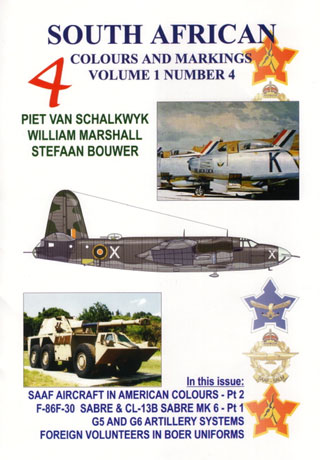|
South
African
Colours and Markings
Vol. 1 No.4
by Piet van Schalkwyk,
William Marshall and
Stefaan Bouwer
S
u m m a r y
|
| Publishers
Details: |
Published by the Authors |
| ISBN: |
IBN 0-620-27418-2 |
| Contents: |
48
pages, high gloss paper with cardboard cover |
| Price: |
ZAR 120 |
| Review Type: |
FirstRead |
| Advantages: |
Excellent coverage of
American aircraft in SAAF service during WW2, as well as of SAAF Sabres
during the Koran War. In addition, this volume covers recent SADF
Artillery developments (G5 & G6) as well as foreign volunteers involved in
the Anglo-Boer War. |
| Disadvantages: |
|
| Recommendation: |
Recommended |
Reviewed by Dr Sinuhe Hahn
To review a book produced by good
friends is not an easy task, however, in this instance it has been a true
pleasure. The SA Colours and Markings series of books have become the
favourite reference source for modellers interested in the SAAF or SADF.
In the case of the most recent volume (Nr.4) I am pleased to announce that
this is the best in the series to date.
 For
those familiar with the series, the authors have followed their standard
layout, which includes a section on the SAAF in WW2, a post war SAAF
period, a section on SADF armour and a smaller section covering uniforms
used in the Anglo-Boer War. For
those familiar with the series, the authors have followed their standard
layout, which includes a section on the SAAF in WW2, a post war SAAF
period, a section on SADF armour and a smaller section covering uniforms
used in the Anglo-Boer War.
In the current volume the major
focus of the WW2 section continues with camouflage schemes used on
American aircraft in SAAF service. This section covers the P-40 Tomahawk
and Kittyhawk, P-51 Mustang, B-26 Martin Marauder and the B-24 Liberator.
Here considerable emphasis is placed on explaining the variety of
American and British colours used. As these were at times used
interchangeably, the authors once again reinforce the need to study
actual photographs of the aircraft one wishes to model. In this regard the
authors are to be commended on providing a host of new data, covering
several schemes and markings, beautifully illustrated in a series of
drawings, all backed up by many previously unpublished photos.
The section on the Sabre in the
Korean War is also very good, as it covers each one of the Sabres used by
the SAAF. Several unusual schemes are included, of which that of a SAAF
Sabre with a USAF sat studded tail is probably the most stunning.
Aviation orientated modellers
have in part criticised the inclusion of armour or uniform sections in
this monographs. Personally, I have not viewed this as a deficit; but then
again, I did not raise my voice in alarm over the inclusion of a
Kettenkrad in the Tamiya Me 262 kit. To me it was fascinating to read of
the number of foreign users now using the G5 and G6 artillery systems, or
the modifications of these systems involving Indian Army T-72 tanks, where
test firings have reached distances of over 40 Km’s.
The section on the Boer War this
time covers a number of foreign volunteers, including American, French,
Scandinavian and Irish contingents. Although this may be of lesser
interest to modellers, it does help us to reflect on why many of us do
build models: because the history fascinates us. As such, delving a bit
deeper to expose the roots can surely cause no harm or as my wife put it,
“ A bit of history has never killed anyone”.
In summary, this is another
excellent volume in a growing series of excellent monographs with are not
to be missed by anyone interested in the SAAF or SADF. The authors are to
be commended on the depth and detail of their research, and for not just
providing a rehash of previously published material. Many of the schemes
illustrated were even unfamiliar to me. What more can a SAAF devotee ask
for? Volume 5, please!
Copies of this limited edition
print are available from:
www.aviationshop.co.za or directly from the authors at:
mechinf@netactive.co.za.
Review Copyright © 2000 by Dr.
Sinuhe Hahn
Page Created 26 November, 2002
Last updated 22 July, 2003
Back to HyperScale Main Page
Back to Reviews Page
|
Home | What's
New | Features
| Gallery |
Reviews | Reference
| Forum
| Search